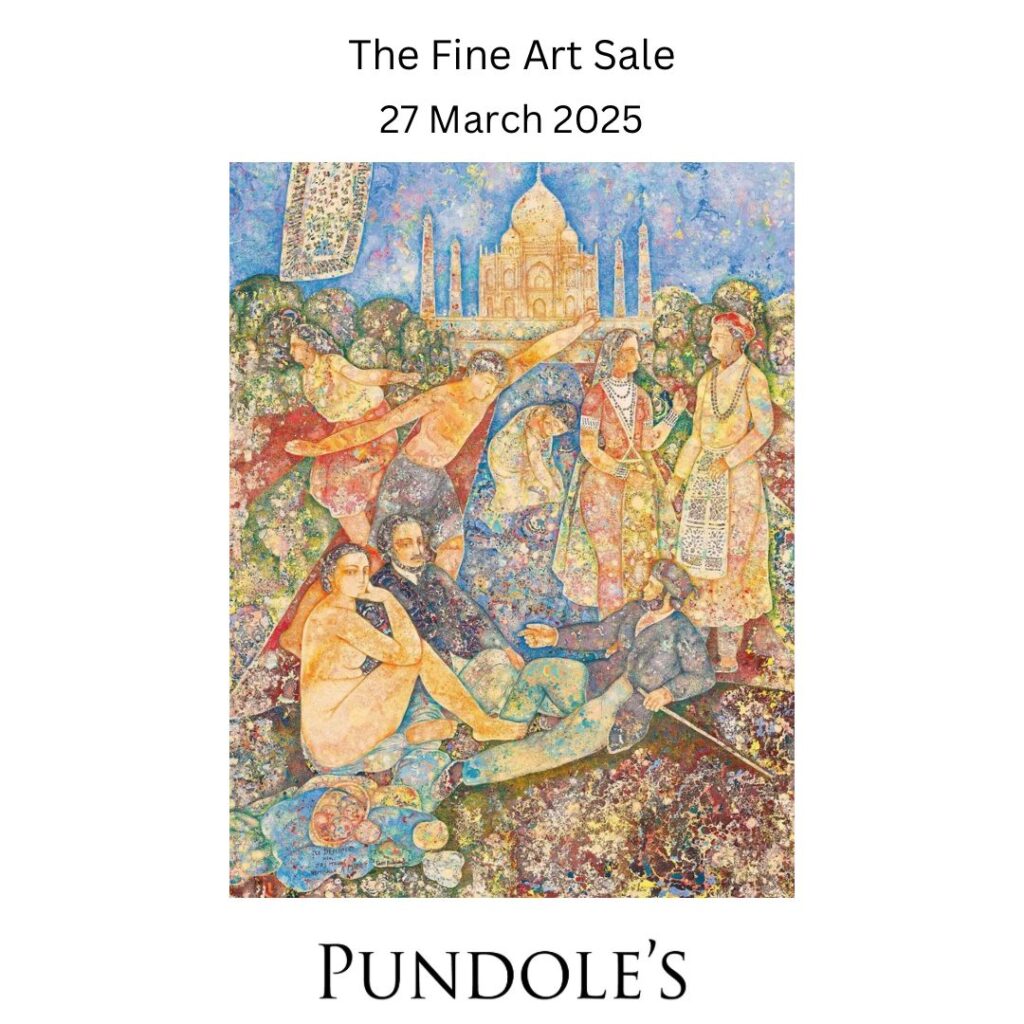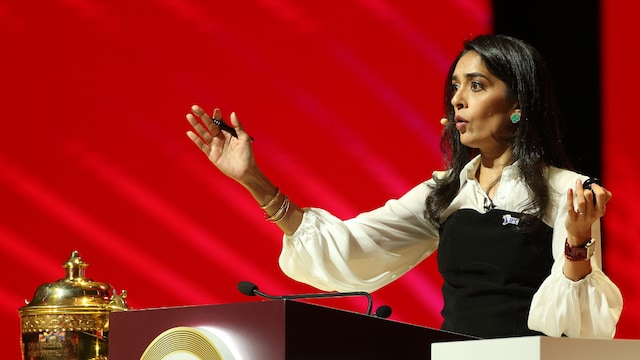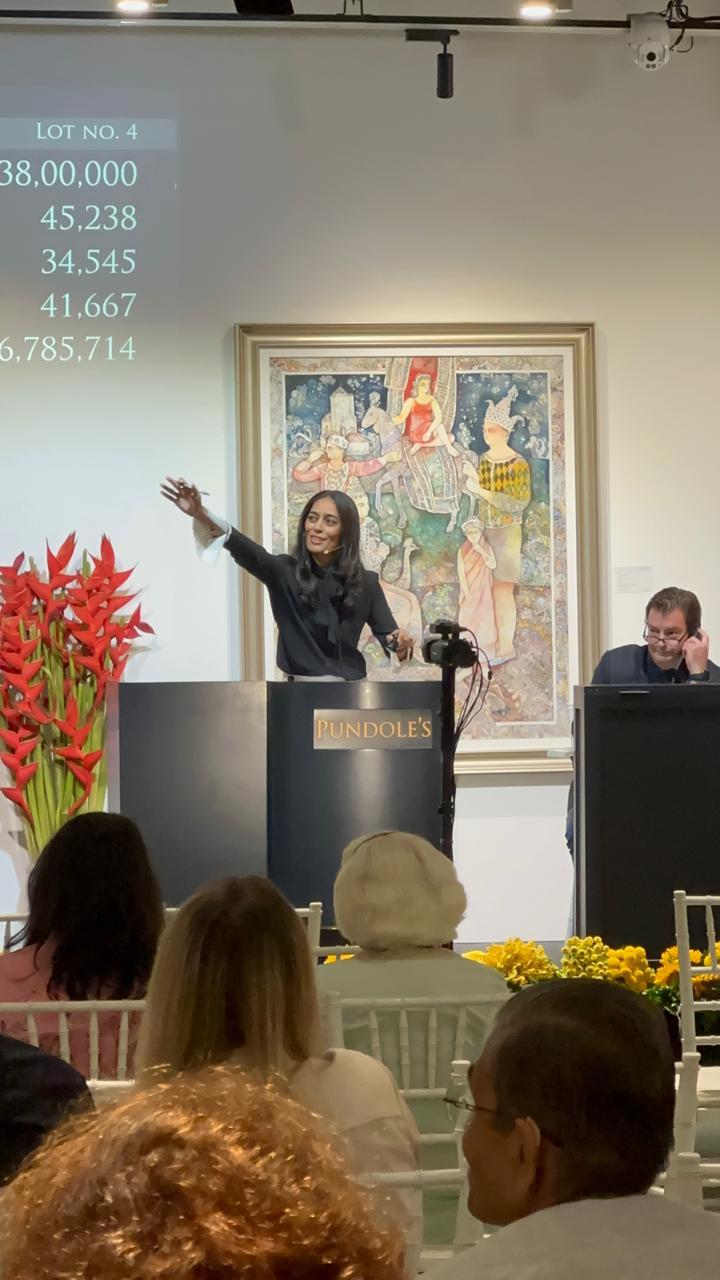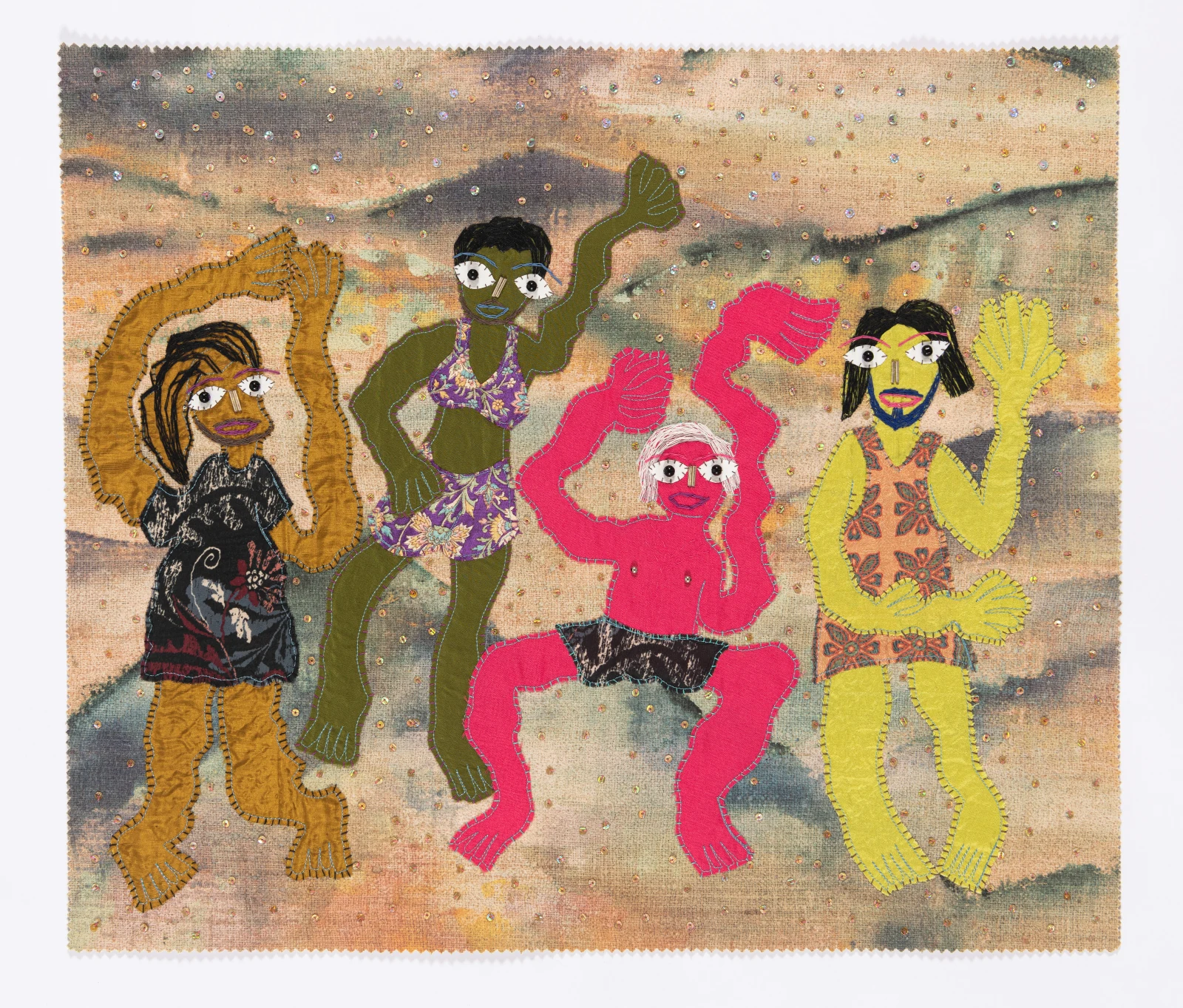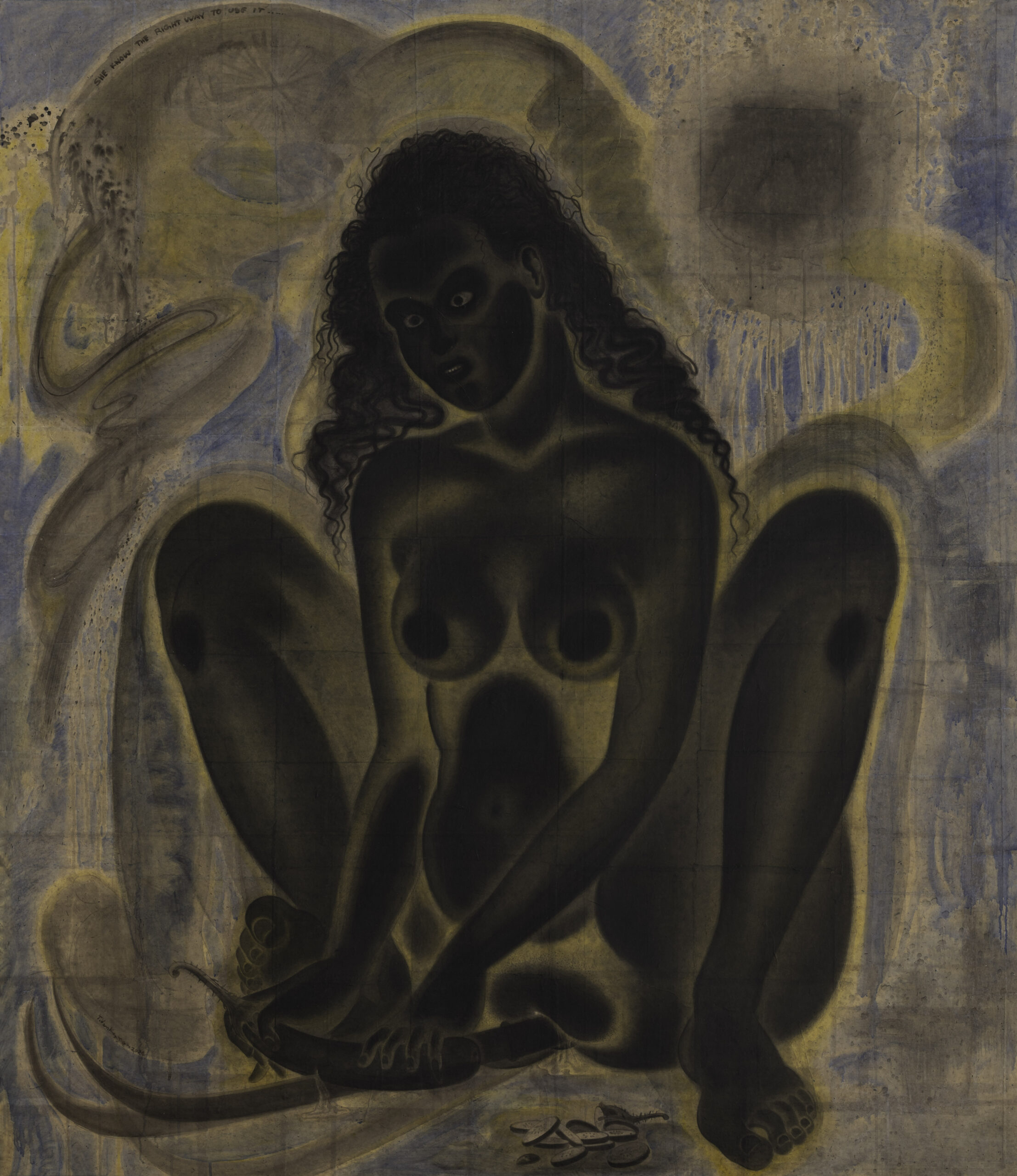Imagine This: Gavel in hand, you’re holding the room—tension building as every bid increases. Going once, Going twice….and SOLD!
This is the world of Mallika Sagar! A Bryn Mawr (Pennsylvania, USA) graduate in art history, she began her career at Christie’s New York in 2000, becoming the first Indian woman auctioneer at the house. Returning to home ground, at Pundole’s, Mumbai, she has led major art sales and also expanded into sports auctions—becoming the first woman auctioneer for the Indian Premiere League (IPL) while also hosting auctions for Women’s premiere League (WPL) and Pro Kabaddi League (PKL).
So how did she get here—and what does it take to hold the room when the stakes are high?
Art Fervour sat down with the calm, incisive, and charismatic Mallika Sagar, who was happy to share her journey and offered practical insights for anyone curious about the world behind the gavel.
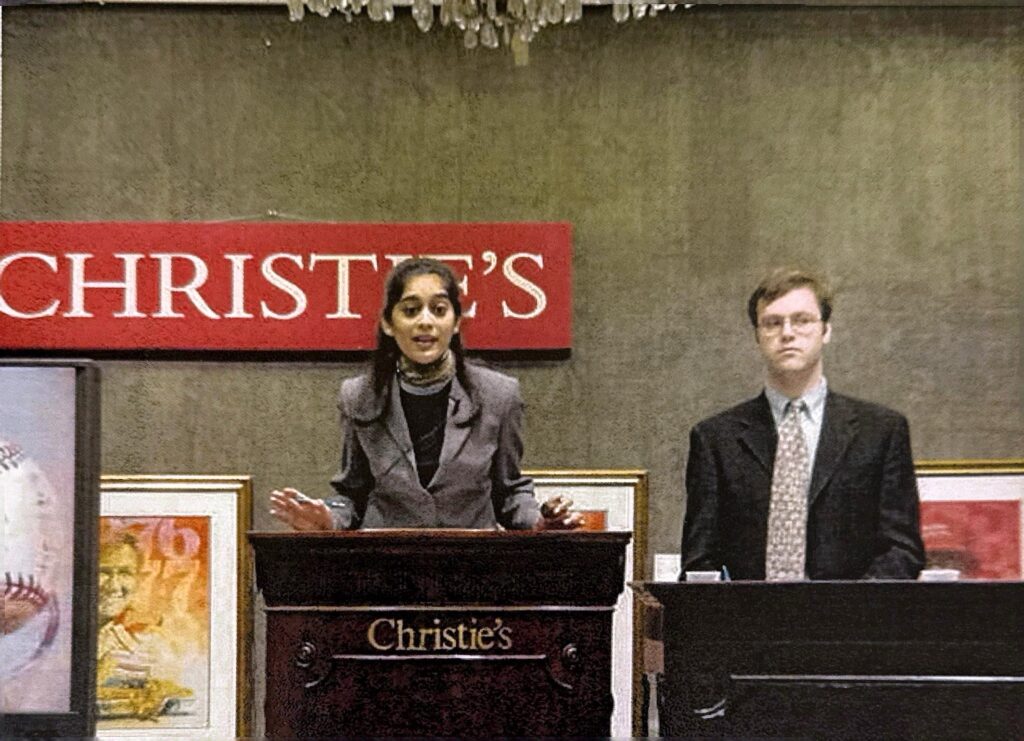
Mallika Sagar at her first auction at Christie’s New York, 2000, Image Credit: Mallika Sagar
- Where did it all begin for you, Mallika? Was there a moment, or a decision, that set you on the path to the auctioneer’s rostrum?
“It’s very hard not to remember your first auction,” says Mallika. “Mine was in December 2000 at Christie’s in New York, where I started my auctioneering career. It was selling baseball memorabilia to a group of very enthusiastic American baseball fans, and I didn’t know much about the subject.”
As a young Indian auctioneer in a room full of seasoned baseball collectors, she had to learn quickly and on the spot. “They were quite surprised to see an Indian auctioneer selling them various very American pieces of memorabilia. But it was great fun.”
She looks back on those early years as a period of trial and error—still finding your footing, learning to read the room, and formulating a style that keeps energy high and holds attention. All of it, she says, only comes with time.

Mallika Sagar, IPL Auction 2023, Image Credit: Sportzpics
- Auctioneering is still a niche profession in India, and you’ve worked across both fine art and sports auctions—two very different fields. What does the role actually demand, and how do you approach it across such contrasting settings?
There’s no fixed path to becoming an auctioneer in India, but for Mallika it all comes down to one’s personality- having confidence, clarity, and being able to hold the room without trying too hard. “Everybody gets a fair chance because it is about you as an individual.”
Speaking about the nuances of each domain in the auctions, she draws a clear line: “In sports auctions, you have to be more sensitive—you’re dealing with athletes’ careers, and one opportunity can change everything.” With art, the focus shifts to getting the best result for the seller. “That doesn’t mean forcing bids, but the approach and mood are different.”
“If you’re doing just charity auctions, I think it’s less about the formal training where you have to balance numbers, and more about having an interactive approach where you can draw bids from the audience, having a sense of humor, and enjoying being in front of a large gathering. For both charity and art auctions, developing a rapport with bidders and creating and building a positive and dynamic energy in the room is very important. For sports auctions, it’s a bit of both because you are dealing with actual people, so you have to be a little bit more sensitive. And it’s not about pushing prices up. It’s not about maximizing prices. It’s really about providing a very open platform and a very clean, clear platform for the teams to buy their players. And then you need a little bit of sensitivity, I think, to handle the players in the best possible manner. Overall, experience is your most valuable asset, as your personality and confidence develop over time.”
The setting may change, but the essentials don’t: know your material, stay calm, and stay focused on the result.
- Auctioneering seems like a unique mix of precision and performance. Is it something that can be taught through formal training, or does it really come down to what you learn on the floor, in real time?
“It’s a bit of both,” Mallika says. Formal training helps lay the groundwork—especially for commercial auctions where understanding increments, reserves, and technical footing matters. “There’s a lot of detail involved, and training helps with that,” she explains. “There’s a bit of theatre in any auction. If you get formal training, you’re taught both the mechanical aspects of it as well as the drama.”
But nothing replaces time on the floor. “Your confidence only really comes out over time. Your own style also develops with time. Don’t try to imitate someone else—your auctioneering style should be an extension of your personality.”
You’ll need to think fast, stay sharp, and juggle multiple things at once. “You do need a head for math and for multitasking,” she adds, especially when tracking bids, managing timing, and holding the room.
There’s no single path in. Some come from art history, others from business or operations. “Both routes are valid,” she says. “When you join an auction house, you’ll spend a few years learning the ropes, and only then might you have the chance to try auctioneering.” Her advice? Don’t overthink it: “It’s always easier just to give it a shot and see how it goes.”

Mallika Sagar At Pundole’s – The First Sale From The Glenbarra Art Museum September 2020. Image Credit: Pundole’s
- Before raising a paddle, there’s often a lot that goes unseen. What should a new bidder keep in mind before stepping into the room, and what kind of preparation really makes a difference behind the scenes?
There’s no need to be overwhelmed by the formality of an auction, but a little research goes a long way. “I think the actual act of raising your paddle is the easy part,” she says.
Knowing what you’re buying is key, and Mallika is clear about the kind of preparation that matters. “What any first time bidder and frankly what any collector should know is they should be very familiar with what they are buying and the procedures that follow any art purchase. ”
Condition comes first. “We spend many hours writing condition reports, very detailed ones, so that every client has access to that information. Is the painting creased even if it doesn’t look creased in the photograph? Make sure that you have checked it. Ask for installation shots. After COVID, everybody’s happy to do installation shots, FaceTime videos to show clients works,” she says.
You don’t have to be a top-tier collector to ask for these details. “Anybody is welcome to do that. We are very familiar with sending reverse shots, forward shots, on view display shots, detailed shots with, you know, for the condition report. Please do your homework on that.”
But the condition report is only one part of the picture. Provenance and authenticity require just as much attention. “It’s also very important to do your homework and due diligence on the provenance of each work. I can only speak for Pundole’s. We spend a lot of time making sure that the artworks we put into our catalog are authentic, and we stand by them. But you have to make sure that you are convinced that what you’re buying is correct.”
Then comes the logistics—especially for international buyers. “If you’re taking the work out of the country, please make sure you understand duties, import duties. Sometimes if you’re shipping a small work overseas, the shipping cost can be more expensive than the value of the work itself. Taxes, these are all things to be extremely mindful of!”
As she puts it, “It’s not just coming into an auction and raising your paddle. That’s the fun part, but you have to do all the background due diligence before that.”

The Pundole’s Team in Mumbai, Image Credit: Pundole’s
- You’ve mentioned several landmark auctions that shaped the direction of Pundole’s—from the standalone Husain sale to the pioneering estate auctions. What do you think made these particular moments turning points for both the market and your approach to curation?
Some auctions stand out not just for what was sold, but for the shifts they marked in collecting practices. “At Pundole’s, I think the two that I find the most important are the standalone Husain sale that we had in 2013, where the entire auction catalog was the property of one Husain collector,” she shares. “And I think it really allowed everyone to see the breadth and the depth of Husain’s work. He’s not just a painter who paints colorful canvases of horses, but there is so much more to the artist. And that auction really allowed a lot of his lesser known works, his lesser known periods to come out, and for everybody to get a chance to buy a particular work depending on what medium they enjoyed.”
She also recalls the significance of Pundole’s first two auctions—property from the estate of Dr. Jamshed J. Bhabha and from the collection of the National Center for the Performing Arts. “I think it firmly established that provenance is very important, and works with great provenance will command a premium no matter what,” she says. “With the second sale, which was the Bhabha House Sale, I think it also firmly established estate sales as a category within India, which had never been done before. So to go into a big large home and sell across collecting categories including porcelain, furniture, lights, carpets, etc.—it was the first time that it had been done in a structured manner with a catalog that gave you lots of information about each piece. And I think that changed the direction of estate sales going forward, at least for us, because we did so many more after that, creating a whole new collector base that would not necessarily have come into us just with art.”
Outside of Pundole’s, she names the first Women’s Premier League auction (2023) as a standout moment: “It really established women as sports people in their own right, where they were going out on their own and being commended and being paid handsomely for being so skilled in cricket in this case. And just being acknowledged as sports people and having that as a career option for me was very important.”

Mallika Sagar, WPL Auction, Image Credit: Cricfit
- With your next sale just around the corner, what should people know—especially those who’ve never been to a Pundole’s auction before?
Pundole’s upcoming Fine Art Sale is scheduled for 27 March 2025, featuring works by some of the most celebrated names in modern Indian art, including M.F. Husain, Gieve Patel and Nasreen Mohamedi. With a broad range of works on offer, the auction invites both seasoned collectors and those new to the scene to engage with significant pieces of Indian art history.
And if you’ve never been to an auction before, Mallika offers a reminder: it’s a space that welcomes everyone. “The very definition of an auction means that it is a public platform… it’s open for anyone to come in either to the viewing or to the auction itself,” she says. “Everybody is welcome to come in. There is no compulsion to buy.”
For many, just showing up can be the first step. “What you’re actually doing is just looking at wonderful art,” she says. “That’s the only way you’re going to increase your visual memory.”
Even though the catalogue may change with every sale, some things stay the same. At Pundole’s, pre-auction rituals for a lucky day are non-negotiable! “Dadiba has to wear the same pair of jeans to every auction,” Mallika says with a smile. “And it’s what we eat for lunch. We’re very particular about that.”
Wishing the Pundole’s team all the luck (and the perfect lunch) for the upcoming auction. Go take a look—you might just surprise yourself.
